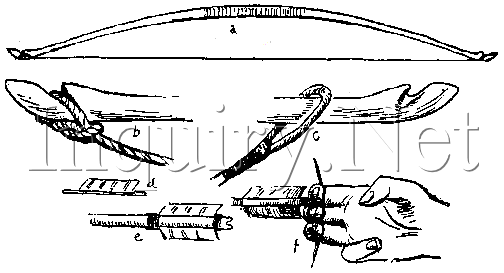by Ernest Thompson Seton
The tribe should own a Standard Target--that is, 4 feet across, circular, made of straw, with a thin oilcloth cover, marked with a 9.6 inch center of gold (called by some of our tribes "The Buffalo's Eye"); outside of that a 4.8 inch band of red, next a similar band of blue, next of black, next of white. Sometimes black rings of the right size are made to answer.
In scoring, the gold is 9, the red 7, the blue 5, the black 3, the white 1. The shortest match range for the target is 40 yards. If it is a 3-foot target the match range is reduced to 30 yards.
A target can be made of a burlap sack about five feet square. This should be stuffed full of hay or straw, then flattened by a few quilting stitches put right through with a long packing needle. On this the target is painted of exact right size.
Each boy should have a bow that pulls from 10 pounds up; about one pound for each year of his age is a safe guide for boys up to sixteen. He should have at least 6 arrows and a quiver. The arrows 25 inches long, with 3 feathers, cone-points of steel or iron; brass points are useless. A guard or bracer for the left wrist is needed, and most boys require a glove to protect the fingers of the right hand.
Bows can be bought, but it is more creditable if you make them yourself.
How to Make a Bow

ARCHERY
a. The bow strung.
b. The cord fast at the lower end.
c. The cord with loop at upper end.
d. Feather ready to tie on.
e. Feathers lashed on.
f. Holding.
Make a straight, sound piece of cedar, bodark, yew, sassafras, muIberry, apple tree, black locust, ironwood, ash, elm, hickory, or hemlock. Cut it so that it is half sap and half heartwood, flat on the sapwood side (or front) and round on the heartwood side (or back). It should be about an inch thick in the middle and tapered off to 3/ 4 inch at each end. Cut two notches and put on a strong linen cord, either a bought bow-string or one made of many twisted linen threads. At one end it is fast to the bow by a timber hitch, at the other by a hard loop.
When strung the string should be about 5 inches from the bow.
Arrows should be 25 inches long, and 3/8 of an inch thick. They are made of pine or ash. The Eastern Indians made them usually of arrow-wood or viburnum shoots.
Each should have a conical steel ferrule for head and three feathers to make it fly true. The feathers are lashed on.

SIX SAMPLE ARROWS, SHOWING DIFFERENT FEATHERS
A is a far-flying steel-pointed bobtail, very good in wind. B is another very
good arrow, with a horn point. This went even better than A if there were no
wind. C is an Omaha war and deer arrow. Both heads and feathers are lashed on
with sinew. The long tufts of down left on the feathers are to help in finding
it again, as they are snow-white and wave in the breeze. The grooves on the shaft
are to make the victim bleed more freely and be more easily tracked. D is
another Omaha arrow with a peculiar owner's mark of rings carved in the middle.
E is a bone-headed bird shaft made by the Indians of the Mackenzie River F is a
war arrow made by Geronimo, the famous Apache chief. Its shaft is three joints
of a straight cane. The rip is of hard wood, and on that is a fine quartz point;
all being lashed together with sinew.
Holding and Drawing
It is very important to begin shooting in correct form and never change from that if you wish to become a good shot.
Grasp the bow in the left hand. Put the arrow on the string with the right. Hook the first three fingers on the string one above, two below the arrow. The little finger and thumb do nothing. (f in top illustration, above)
Stand perfectly upright, left side toward the target, the heels 12 inches apart and in exact line from the target. Hold the bow upright and the arrow against the left side of it, resting on the hand. Draw the cord till the head of the arrow touches the bow and the top of your thumb rests on the corner of your mouth. You must sight along the arrow for direction, but guess for elevation. Hold it one second.
Release the arrow by straightening your fingers and at the same time turn your hand back up, but keep the thumb tip at your mouth corner. Do not move the left hand a hair's-breadth till the arrow has struck.
Begin practicing at very short range and slowly increase up the standard, forty yards.
Unstring the bow when not in use.